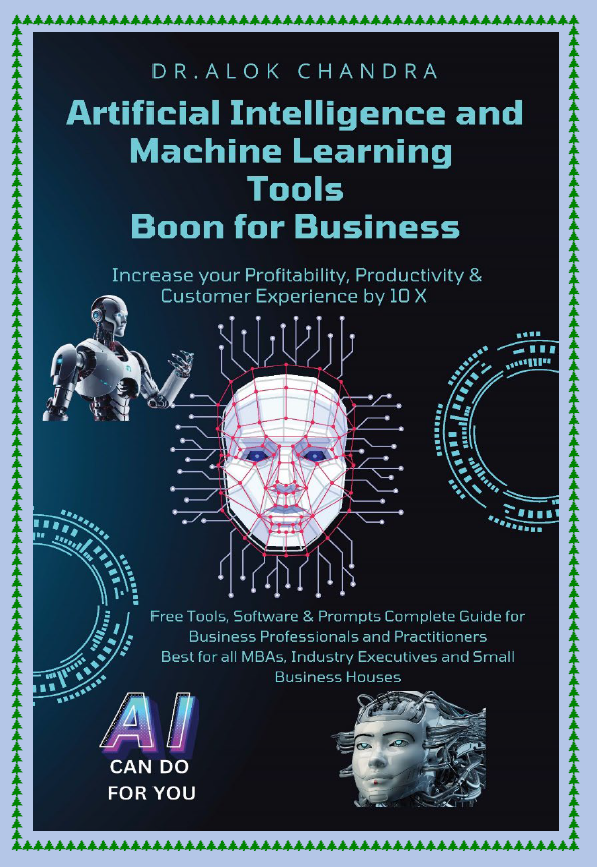GLOBAL SKILL UNIVERSITY
"Artificial Intelligence and Machine Learning Tools Boon for Businesses” Increase your Profitability, Productivity & Customer Experience by 10 X with AI tools
"Artificial Intelligence and Machine Learning Tools Boon for Businesses” Increase your Profitability, Productivity & Customer Experience by 10 X with AI tools
Couldn't load pickup availability
This document, authored by Success Guru Dr. Alok Chandra, serves as a comprehensive guide on the transformative impact of Artificial Intelligence (AI) and Machine Learning (ML) on industry and business. It explores foundational concepts, practical applications across various sectors, ethical considerations, and a wide array of AI tools and platforms designed to enhance productivity, decision-making, and customer engagement in the modern technological landscape .
Introduction to Artificial Intelligence and Machine Learning
AI refers to machines performing tasks that typically require human intelligence, such as problem-solving and decision-making. Machine Learning, a subset of AI, involves training machines to learn from data and improve over time without explicit programming. Key AI technologies include Natural Language Processing (NLP), which allows machines to understand human language, and Deep Learning, which uses neural networks to identify complex patterns in data. Neural networks mimic brain functions and are essential for tasks like image and speech recognition. Different types of neural networks, such as feedforward and recurrent networks, serve various functions in AI systems .
Algorithms and Data Processing
Machine Learning algorithms—supervised, unsupervised, and reinforcement learning—are critical for enabling AI systems to analyze data, recognize patterns, and make predictions. Data processing steps include data collection, preprocessing (cleaning and formatting), feature engineering, and model evaluation to ensure accuracy and effectiveness. Ethical and societal implications, including bias, privacy, and job displacement, are important considerations when deploying AI technologies .
Understanding AI Chatbots and Language Models
AI chatbots, such as ChatGPT, simulate human conversation using generative models that create responses based on input rather than pre-defined replies. ChatGPT processes language as tokens—units of information smaller than words—and is trained using large datasets and advanced techniques like Transformers and Reinforcement Learning with Human Feedback (RLHF). This training enables ChatGPT to generate fluent, context-aware responses, though it may occasionally produce inaccuracies or biases due to human input during training. The document also compares ChatGPT with other AI chatbots like Bing AI and Google Bard, highlighting their respective strengths and limitations .
Prompt Engineering
Prompt engineering is the practice of crafting effective inputs (prompts) to AI chatbots to elicit desired outputs. It involves defining context, specifying tasks, and refining prompts iteratively. Good prompts improve AI responses in domains such as customer support, data analysis, and corporate training. The document provides detailed examples and guidelines for writing better prompts, including business-specific prompts for marketing, sales, customer service, and human resources .
Applications of AI and ML in Business
AI and ML technologies have widespread applications across various business functions:
• Accounting: Automating cash flow projections, transaction categorization, and financial forecasting.
• Content Generation: Creating marketing materials, documents, and multimedia content.
• Customer Service: Enhancing support with chatbots and sentiment analysis.
• Cybersecurity: Monitoring systems and detecting threats.
• IT Operations: Automating infrastructure management and anomaly detection.
• Financial Services: Fraud detection, risk assessment, and personalized customer assistance.
• Human Resources: Automating recruitment, payroll, onboarding, and employee engagement.
• Legal: Document review, research, and risk assessment.
• Sales and Marketing: CRM integration, personalized campaigns, and content creation.
• Supply Chain and Logistics: Forecasting, inventory management, and operational automation .
Industry Case Studies
The guide highlights successful AI and ML implementations in key industries:
• Retail: Personalized marketing, inventory management, demand forecasting, and fraud prevention.
• Healthcare: Diagnostics, medical imaging, administrative automation, and patient support.
• Financial Services: Real-time fraud detection, credit risk assessment, investment optimization, and customer interaction enhancement .
AI Tools and Platforms
An extensive directory of AI tools is presented, categorized by business needs:
• Sentiment Analysis: IBM Watson, Hootsuite Insights, Clarabridge.
• Marketing Automation: HubSpot, Marketo, Pardot.
• Sales Enablement: Salesforce Einstein, Outreach, Salesloft.
• Customer Relationship Management (CRM): Zoho CRM, Salesforce, Pipedrive, Freshsales.
• Content Creation: Canva, Jasper, Article Forge, Copy.ai.
• Data Analysis: Julius.ai, Rose AI, Kaggle.
• Automation and Workflow Management: UiPath, Automation Anywhere, Zapier.
• Video and Image Editing: Synthesia, Runway, Midjourney, Photopea.
• HR and Talent Management: Eightfold.ai, MyCaptain, Textio, HireVue.
• Supply Chain and Logistics: FourKites, Kinaxis, Blue Yonder.
• Social Media and Advertising: Buffer, Buzzsumo, AdCreative.ai, Drift.
• Legal AI: Harvey, LinkSquares .
Ethical, Workforce, and Integration Considerations
The document discusses challenges in AI adoption, including:
• Ethical and Privacy Issues: Governance of data, bias mitigation, and accountability.
• Skill Gaps and Workforce Transformation: Need for AI literacy, potential job displacement, and the importance of human-AI collaboration.
• Integration Challenges: Compatibility with existing systems and flexible technology stacks to enable seamless AI deployment.
• Future Trends: Collaboration among governments, businesses, and individuals; AI as augmentation rather than replacement; and emerging AI-driven business opportunities .
Conclusion
AI and ML stand as revolutionary technologies reshaping business by automating processes, enhancing data-driven decision-making, and improving customer and employee experiences. While offering significant productivity and growth benefits, responsible adoption addressing ethical, workforce, and integration challenges is essential. The future envisions a synergistic partnership between human intelligence and AI, driving innovation and redefining entrepreneurship .
About the Author
Dr. Alok Chandra is a distinguished professor, author, and corporate mentor with a rich background spanning academia, industry, and the armed forces. He currently serves as Vice Chancellor of Global Skills University–Virtual, Mumbai, and has contributed extensively to AI education and business transformation. Known as the “Success Guru,” he advocates democratizing AI knowledge to empower professionals worldwide .
Share

